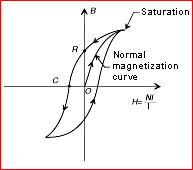Fluorescent lamps are reasonably efficient at converting input power to light. Nevertheless, much of the power supplied into a fluorescent lamp-ballast system produces waste heat energy.
Hysterisis Loop When a electric current flows through a conductor ( copper wire), it generate a magnetic field. The magnetic field is strongest at the conductor surface and weakens as its distance from the conductor surface is increased. The magnetic field is perpendicular to the direction of current flow and its direction is given by the right hand rule shown below. When the conductor or wire is wound around a magnetic materials ( ferrite, nanocrystalline, amorphous, iron, steel, MPP, sendust, high flux, mega flux, etc), and current flows through the conductor, a flux is induced on the magnetic materials. This flux is induced by the magnetic field generated by the current carrying conductor. The magnetic material's atomic parts got influenced by the magnetic field and causes them to align in a certain direction.
The magnetic properties are characterized by its hysterisis loop, which is a graph of flux density versus magnetization force as shown below:


There are three primary means of to improving the efficiency of a fluorescent lamp-ballast system:
Newer, more energy-efficient ballasts, both magnetic and electronic, exploit one or more of these techniques to improve lamp-ballast system efficacy, measured in lumens per watt. The losses in magnetic ballasts have been reduced by substituting copper conductors for aluminum and by using higher grade magnetic components. Ballast losses may also be reduced by using a single ballast to drive three or four lamps, instead of only one or two. Careful circuit design increases efficiency of electronic ballasts. In addition, electronic ballasts, which convert the 60 Hz supply frequency to high frequency, operate fluorescent lamps more efficiently than is possible at 60 Hz. Finally, in rapid start circuits, some magnetic ballast improve efficacy by removing power to the lamp electrodes after starting.
Metal Halide Ballasts | High Pressure Sodium Ballasts | Fluorescent ballasts | Gear Tray
Links: Porcelain lamp socket | Mercury Vapor Ballast | Light bulb socket
Xml Copyright: @2012-2020 James Lighting Electronic Co.,Ltd